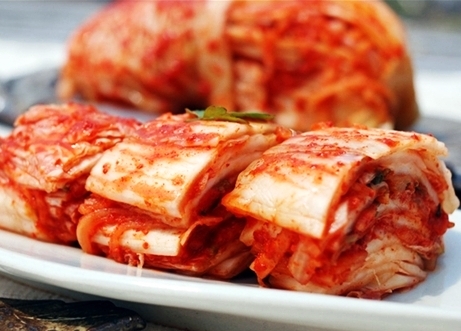
How to Ripen Kimchi
Everyone has a different preference as to when Kimchi(김치) tastes the best – some love eating freshly made, raw kimchi (kind of tastes like a salad); some love eating it when it is just perfectly ripe and then there are those who love sour kimchi (신김치 shin kimchi) which has basically over fermented and obviously tastes quite sour. But one thing is for sure – no one likes the stage when it is in the in-between stages of being raw and ripe. Kimchi really does not taste good at all when it is in the process of getting ripe – I had an aunt who used to call this the time when kimchi has gone CRAZY! And you certainly don’t want to eat the kimchi when it’s crazy! 🙂 So here’s how to ripen Kimchi and avoid CRAZY kimchi.
Since most of us now buy kimchi from the store, let me first write about the best way to eat a store bought kimchi. Too often, I hear people say that the kimchi served at our house tastes great, but when they try the same brand themselves, they think it doesn’t taste nearly as good. I realized it was because they don’t take the time to ripen it properly and then also forget to serve it cold (right out of the fridge). I found that most kimchi (even the poorly made ones) will taste quite palatable when they have had time to ripen properly.
Now, the hard part about buying kimchi from a store is that it is hard to tell at what stage of the fermentation process they are in. One clue is the appearance of the vegetables. They will look more shriveled up if they are further along in the fermentation process. And the chances are that it will also have lost a bit of the juice because the content will start to bubble and balloon up when it ferments which ends up usually overflowing out of the jar. This is actually too bad because kimchi should always be immersed in its own juices for it to taste the best.
The best way is to buy the freshest kimchi possible and bring it home and ripen it from the beginning. But this is usually not possible…So far, I have found the best tasting kimchi that you can buy are actually the ones that are directly imported from Korea (종가집Jongajip is my favorite). It is expensive but worth it in my opinion as long as it hasn’t traveled too far or stayed on the shelf too long at your store. Other than that, the next best thing is to try to buy kimchi that is made locally if it’s available (less chance of it over ripening) and when you bring it home, open it, smell it or better yet, taste it. If your store has a fast turnaround, it is probably in the “crazy” stage.
If it’s already fully ripe, put it in the fridge in the coldest possible setting. If it’s not yet fully ripened and you can wait, let it ripen in your fridge. This will take about 2 weeks in your fridge. Also note that the juice may overflow so either move the kimchi into a bigger container or take some out (1/5th) and leave some room for the kimchi to expand. If your kimchi is still very fresh, not at all ripe and you need to eat it quickly, you can ferment it at room temperature.
In the summer, Kimchi will ripen in 12 ~ 18 hrs and in cooler weather it can take about 24 – 48 hrs. Just check every 4-6 hrs.
If this is all too much info for you to digest, I have a chart at the bottom of this post that can help you with the process. (Boy, it’s been ages since I drew up a flowchart…brings back memories from my college days of hand drawing the charts using graphic rulers..)
What is the ultimate best way to ripen or ferment kimchi?
The most delicious and fantastic kimchi is made when it is fermented the old fashioned way…In a traditional Korean clay jar, buried in the ground in winter time. Even though the ground freezes in the winter, the jar and the saltiness of the kimchi keep it from freezing completely. This is called 김장김치 (kimjang kimchi). Kimjang kimchi is usually made around the ‘start of winter’ (입동 ipdong) in the lunar calendar which is just about now (Nov 7-8th in Gregorian calendar).
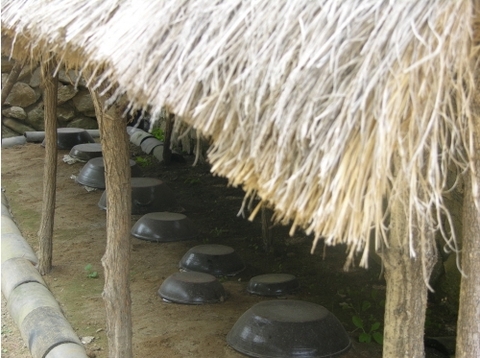
I remember when I was a kid, we spent days preparing and making kimjang kimchi so that it could last us through the winter and into spring. We first dug big holes in the ground big enough to hold our huge clay jars (so big that a child can fall in). In the meantime, we spent the day washing and brining 100+ napa cabbages and also preparing the ingredients for the stuffing. The next day we took these salted napa cabbages and inserted the stuffing in between each cabbage leaf. It was an enormous amount of work but boy…was it worth it. All winter long, we got to eat these amazingly crunchy and zingy and sometimes even ever so slightly frozen kimchi that came out of these jars in the ground. So why was it so tasty?
According to research, when it is buried in the ground, the temperature remains quite constant – at 32 – 35 F all winter long. At this temperature it takes about 20 days for the kimchi to fully ripen but it is definitely worth the wait.
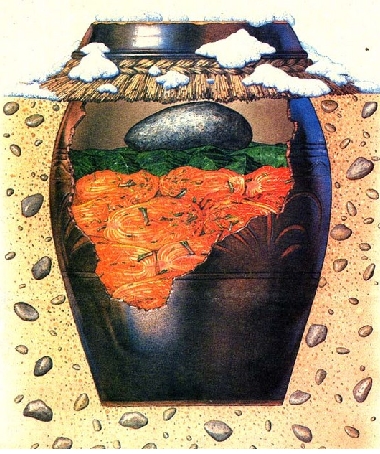
The clay jars are glazed to hold the moisture in but it can still breathe which allows just the right amount of air circulation to take away any heat produced from the fermentation (keeping the temperature stable). It also keeps the air tight enough for the bacteria to not grow too fast which helps the kimchi maintain its peak flavor for a longer period. The history of kimchi can be dated back almost 2000 years to the Goguryo Dynasty according to some historians, so you can see how long Koreans had time to refine the technique of kimchi making.
Since most Koreans now live in apartments and have no backyards to bury the jars, they have invented what is called a kimchi refrigerator. This fridge is different from the conventional refrigerator because the interior walls of the fridge are cooled instead of the air which helps to keep the interior at a more constant temperature. I own one and I have to say it is the next best thing to having your own kimchi jar in the ground. It even has temperature options for fermenting and then just storing it to prolong its freshness.
How to tell if Kimchi is ripe and ready to eat?
When a kimchi is not fully ripe, you are able to smell and kind of taste the individual ingredients – garlic, cabbage, radish, green onion, fish sauce, etc – as they have yet to fully integrate with each other. When it is fully ripened, the tastes of all the ingredients are well blended together and there is full flavor embedded in each cabbage leaf or vegetable pieces. There is also a slight sour taste with an added zing at the end. You can also no longer smell the raw ingredients individually but rather have a combined, wonderful slightly stinky smell that is unique to kimchi. Below is the chart that I promised earlier –
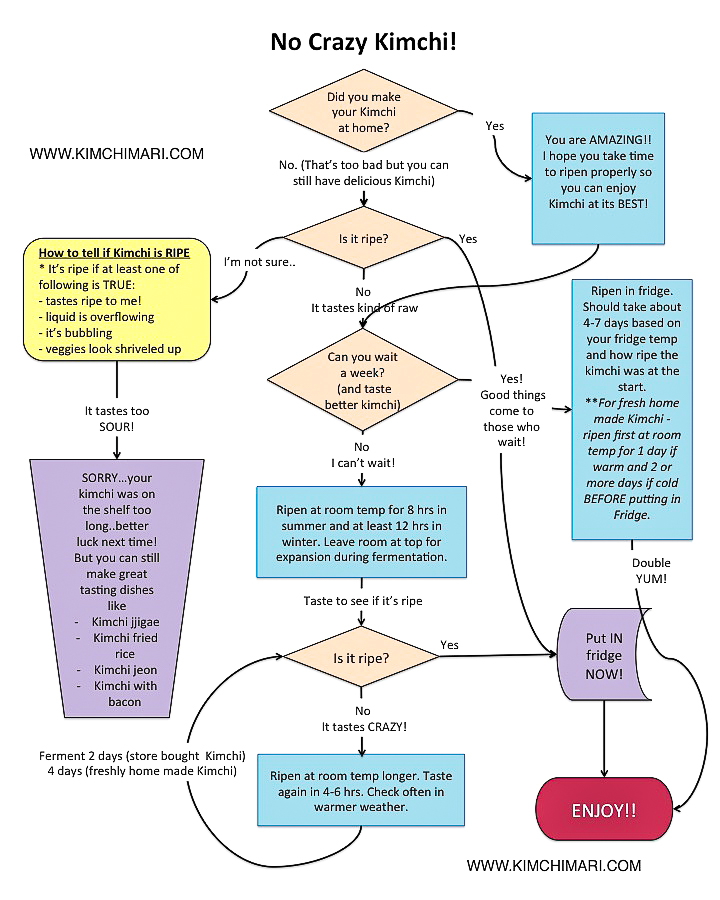
So how long can I store Kimchi in the fridge?
When stored at the ideal temperature that’s close to the freezing point of 32 F (-1 to 0℃), kimchi will keep for 3 months or more.
If the temperature of your fridge is higher (which is normally the case), it will probably keep for at least a month or more. Kimchi will start to taste just too sour when it starts to go bad – at which point, the best way to eat them is by cooking them by making Kimchi Jjigae, Budae Jjigae, Kimchi soft tofu stew, Kimchi fried rice and of course Kimchi Mari! Kimchi will sometimes go bad – it will have this whitish kind of film when it has been really too long and will also smell very pungently sour. You don’t want to eat it at this stage.
Can I take my Kimchi out from the refrigerator and leave it on the counter again to ripen further?
YES! Whether you have store-bought kimchi or made your own kimchi, you can take Kimchi out of the refrigerator at any time and let it ripen or sour further.
If it’s not ripe enough, it will take a long time to ripen in the fridge.
The whole point about my flow chart above was for people who have store-bought Kimchi. You may think it’s ready to eat because you got it from the store, but many times they are not fully ripe and therefore doesn’t taste as good.
Well, I hope this was helpful. Please share this info so that more people can learn how to ripen Kimchi properly and enjoy it at its best!
Take care,
XOXO
JinJoo
PS – if you want to learn more about Kimjang, here are two posts that teach you all about it!
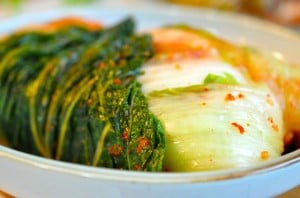 kimjang kimchi
kimjang kimchi- Kimjang Day: Part 1- How it’s done – I share my experiences and tips learned while doing Kimjang with my mother-in-law.
- Kimjang Day: Part 2 – Ingredients and Tips

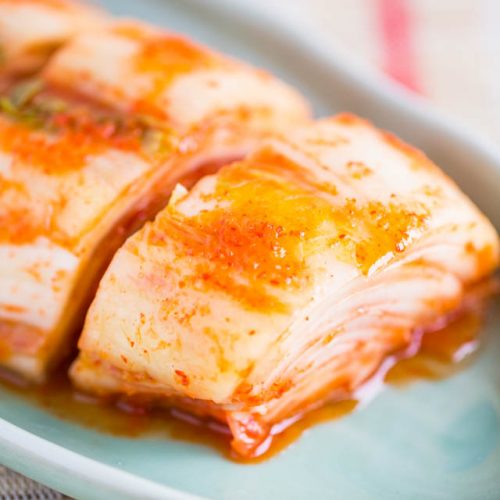
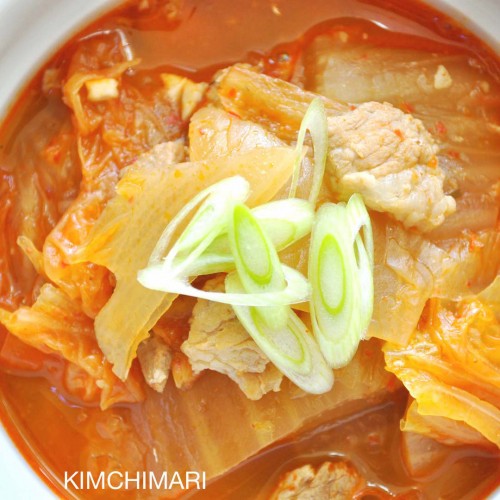
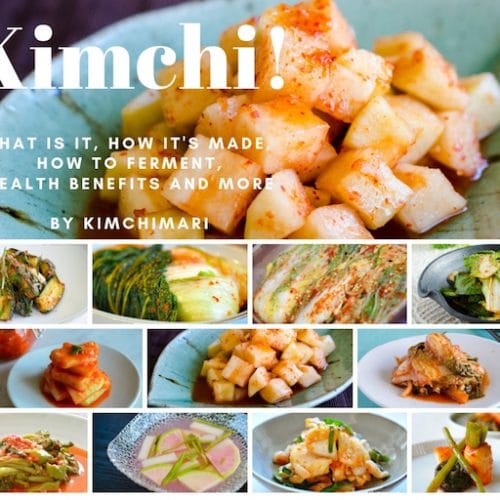
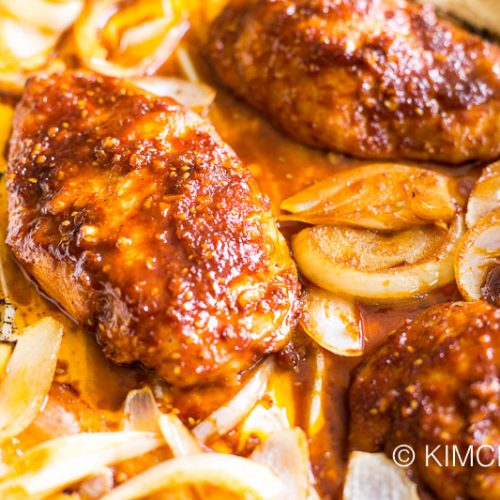
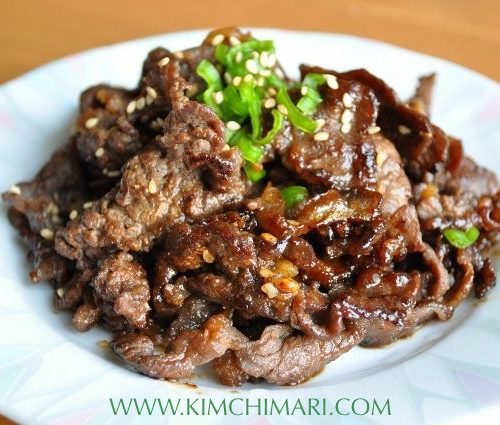
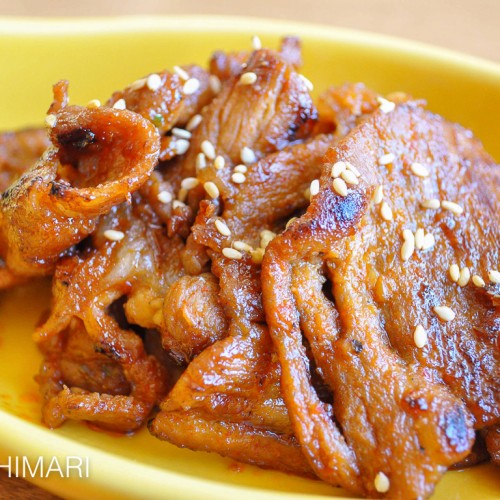

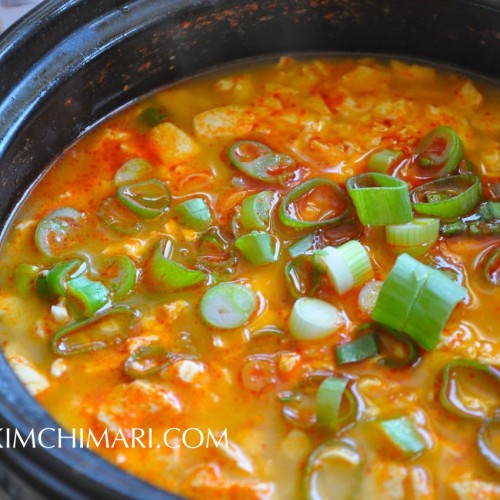
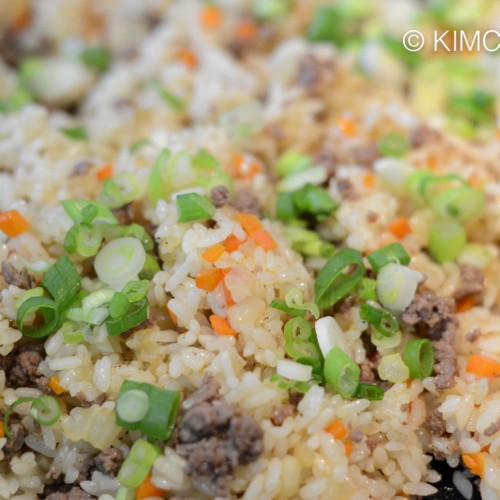
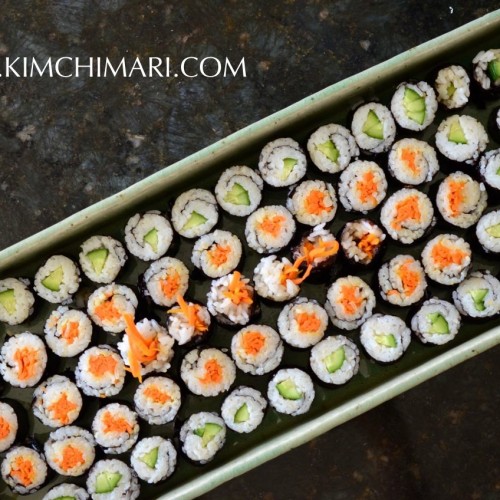
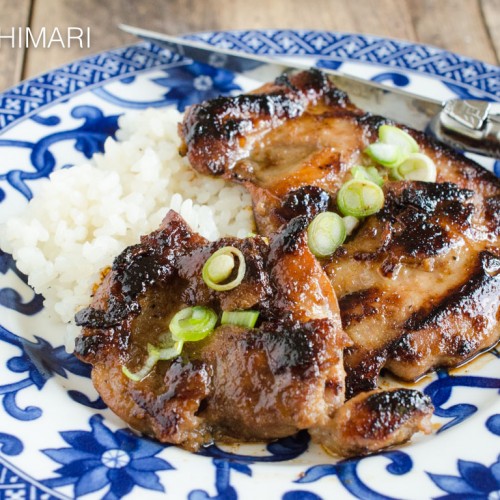








Thx for the info, now I know why they make the kimchi claypot like that.
Was watching a pbs show called “Kimchi Chronicles” – they say kimchi is like wine & cheese that lasts years. Is that true just in Korea b/c of the low temp and dry air weather? Can last that long if you keep it in the fridge? Even if you are living in a more humid region?
I have tasted kimchi that was few years old (3 years?) but not much older than that. In order for you to be able to make kimchi last for years, everything has to be perfect – salinity and quality of salt, the quality of the cabbage (cabbage grown in Korea fall weather is best), the seasonings and finally the preservation environment. If you are able to keep it at a constant temperature (there are kimchi companies who keep them in a cave) it can certainly keep for years assuming the ingredients used are high quality.
With a kimchi fridge, you have the best chance of keeping it longer (prob. up to several months). In a normal fridge, it will probably last a couple months at most.
Humidity is not a big factor in keeping kimchi fresh. The temperature plays a bigger role and keeping the kimchi immersed in the liquid is very important in keeping the kimchi fresh as this protects the kimchi from picking up bad bacteria from the air.
Thanks for the great article. You should rewrite the Wikipedia page on kimchi! 🙂 So now to my question(s) :
(1) As I eat my kimchi, the liquid in the jar goes down quicker than the vegetables, and they begin to dry out and lose their texture. Do I need to keep the vegetables immersed, and if so, what should I use to top up the liquid? Or is it ok to keep eating it as it is? (I’m concerned about making myself ill and also losing the probiotic qualities of the kimchi)
(2) How long can I keep my (store bought) kimchi in the fridge? i.e. does it ever ‘go off’ or does it simply continue to ferment?
Thanks so much for your time,
Matt
hi! 1) More often that not, the liquid does go down quicker than the vegetables. And you are right, the kimchi that stays outside of the liquid will not taste as good and eventually start to go bad. It is best to keep it immersed as much as possible. Everytime you take out the kimchi, press the vegetables down with your hands as much as you can. Topping off kimchi with a liquid after it has fermented is really not recommended – it changes the taste. Another thing that Koreans do is to sacrifice a few pieces of the vegetable and use it as a “cover”. So you basically remove the top layer to take out the kimchi and then put the top layer back on afterwards. Cabbage kimchi works best for this as you can use large cabbage leaves to cover the entire top surface. You will not get ill just because the kimchi is dried out but it is best to cook the kimchi (it tastes better this way) once it has become really sour.
2) I think I have mentioned in the post that different people have different say on how long you can keep kimchi in the fridge. I think under ideal circumstances it can go for years but unfortunately with our modern way of making kimchi, I think it is safer to keep it until you feel it is starting to either look bad (becomes really mushy, vegetables look yellow, sometimes white, yellowish mold appear – any of the above). I would say in general you can keep it in the fridge up to couple months but probably no more than that.
Thanks so much for your compliment!! It really makes it all worthwhile.
Hi! I just found your blog because I was searching for a word I learned last night and forgot. I went to a restaurant with a Korean friend and was bowled over by the deliciousness of the kimchi. I’m one of the people who likes it fresh. So he told me, “In Korea we call this kind ____ kimchi.” It was a word with three syllables and a few ㄱsounds. Would you have any idea what that was? He’s currently on a plane back to Seoul, so I can’t ask him. 🙂 Thanks!
I’m glad you found my blog! To describe unripe, fresh kimchi, did he possibly say 덜익은(dulligeun) kimchi? 익은(igeun) means ripe and 덜(dull) means less. The only other word that I can think of that describes the unripeness is the verb 설다(sulldah) which means not fully ripe. Using the adj. form, 선(sun)kimchi is another way and then finally he could have said 설익은(sulligeun) kimchi. Hope it helps!
Hi! 😀 Thank you for your reply. I don’t think that 덜익은 was the word, but I could be wrong. I guess I should email him to find out for sure. I’m glad I found your blog, too. I see some great recipes here. I like all your tips and food history. Thanks again!
Okay! I’m ready to try. Going to wait a week and hopefully have better tasting kimchi. My first time making this so I hope its a success b/c I could eat kimchi all the time.
*Thanks for the detailed explanation. I appreciate it and definitely trust it coming from an expert kimchi maker. ^^*
Thanks so much! Wish you all the best with your kimchi. Don’t forget to taste it every now and then to see how it’s coming along.
Well, I’m mad. The crummy refrigerator has spoiled a second batch of beautiful kimchi – another batch made with everything , including minari, oysters, kat – it was delicious, and it’s been spoiled by a refrigerator that randomly freezes things in the refrigerator section. Where, please, in the Bay area, can I get a kimchi refrigerator? I don’t want to shop online unless there’s no other choice. Thank you! (BTW, the pumpkin kimchi came out very well, although the fridge tried to do it in, too. It makes amazing kimchi jjigae.)
Oh dear! That’s terrible..I think you definitely should invest in a kimchi fridge, since you are making so much yourself. I bought my kimchi fridge from a store called Cosmos Gift shop in Santa Clara (El Camino). But this was almost 8 years ago so not sure if they still have it. If you do visit, you can also try haggling a bit (if you like that sort of thing) – ask them for a better deal and they will usually give you some discount.
I have seen some big Korean supermarkets also sell them in other states but in the bay area, I have seen them in Korean housewares/gift shops mostly. Good luck!
Found it! Cosmos is about 2 miles from me, so I headed over there and they have them, 2 models in stock and one coming. Now to decide, 1 or 2 compartments (my budget won’t stretch to the big one). They carry Dimchae, whose English site is surprisingly hard to find: http://www.dimchae.com/eng/ Their USA site is mostly in Korean. Thank you!
Great! Yes, Dimchae is THE original kimchi fridge. I had mine for 10+ years and still works great. 2 compartments is useful if you want to store something other than kimchi – avoids having everything smell like kimchi. You can use one to store dried foods, fruits or whatever. Peaches stay fresh for weeks instead of days in this fridge.